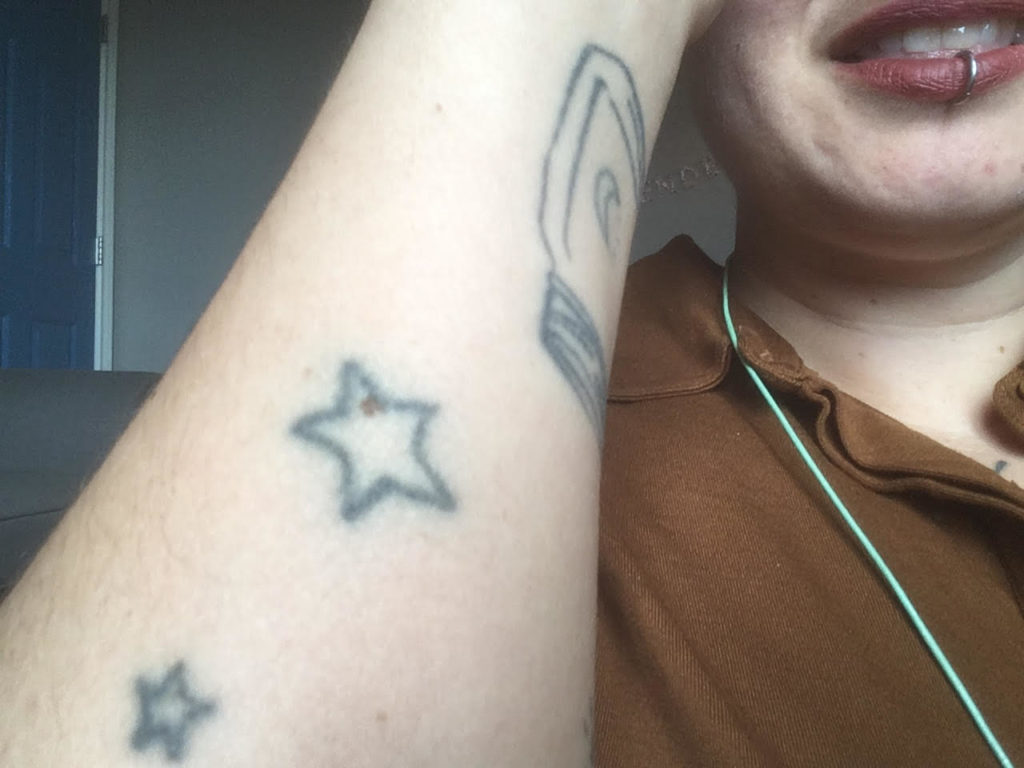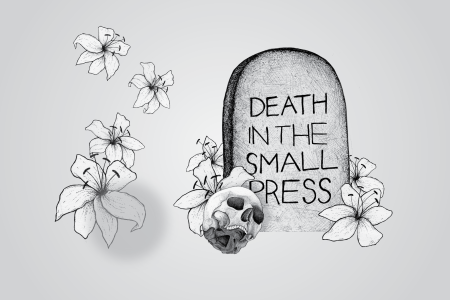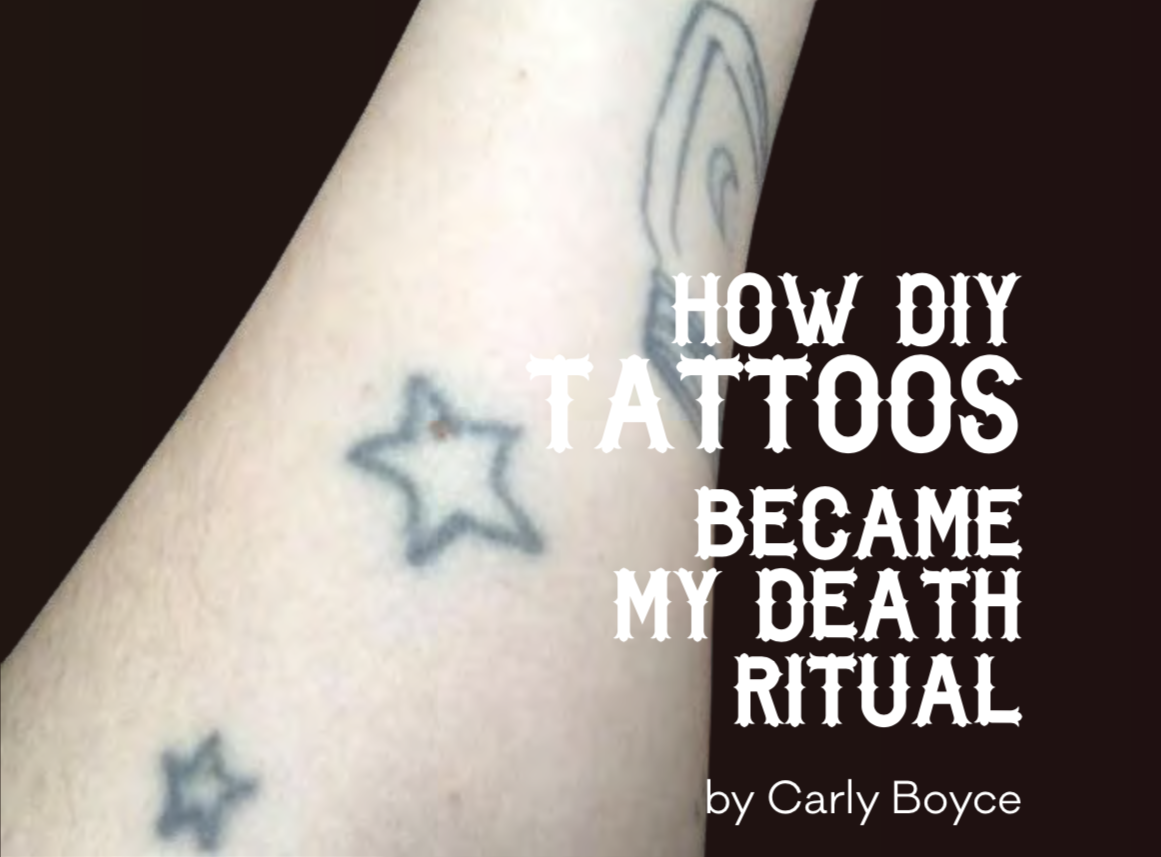
A tattoo starts as a wound. It heals, but it won’t disappear.
I learned this when my friend Ali was dying of brain cancer in 2009. One night, my bestie Noah and I looked up an Instructables tutorial, drank too much whiskey, and took turns tattooing each other in their bathroom. Since then, I have worn a shooting star on my forearm, its outline encircling a freckle. They now have a tattoo of the symbol for the square root
of -1 on their wrist — an impossible number standing in for impossible feelings.
Shortly after Ali died, a collection of her friends in Montreal gathered in the chapel at McGill University, decked out in our gender- fucked finery, and all told stories about Ali and dirty jokes she would have liked. Afterwards I hosted a wake where people got drunker and sadder and sillier. Some folks brought instruments, and a banjo and autoharp that met that night still haven’t parted ways.
I got a professional tattoo in Ali’s honour too, also a math moment: the mathematical symbol for permutations followed by the alphabet in parentheses — shorthand for everything that can be said in written English and other Roman alphabet languages. If it is not solely a prayer, it certainly can make one.
After acquiring the basic skills to hand-poke tattoos, I got casual with the practice, but looking back, it seems like all of these tattoos were rituals. I’ve poked tiny symbolic acorns on about 20 people, comrades from a summer program for queer and trans kiddos. My acorn is on the ring finger of my left hand; I married in. My pal Cee and I tattooed the word “INTENSE” in capital letters on each other’s thighs, an affirmation of too much-ness. I give and get tattoos in moments of transition, to set intentions or solidify lessons. I also frequently use tattooing as a ritual technique, a means of responding to death and other losses.
I was nervous when my covenmate Eroca asked me to be the tattooist in their performance piece Truthteller, part of a trilogy revolving around consent, transparency, and grief. I’m not a performer, but I like to be useful, and I had the skills they needed for this ritual — plus I had her trust. At each performance, we add to their tattoo, and when it’s done, so will be Truthteller.
Part 2 of 3 was a piece called Taking it to the Grave, essentially a living funeral for Eroca’s art and life partner, Glam Henderson.
I was invited to reprise my role as ritual tattooist (as well as middle finger-only manicurist) in the living funeral in fall of 2016, so I packed my inks and travelled to Winnipeg. The concept of the performance was this: audience members confessed secrets to Glam as he laid out on a chaise lounge wearing white and gold. Together, they designed a symbol that represented the secret that had been shared. Then, I knelt bedside Glam to get close to the arm, and poked in the tattoo while the confessor held her other hand. There was also a champagne baptism, a dance party, and a beautiful mess of giant gold glitter happening all around with guests, Eroca, myself, and, the heart of it all, Glam.
Though it was at capacity with bodies, that gallery was packed with ghosts. We have so few spaces that invite us to engage honestly with death and grief. When you open such a space, people will go hard. And, they bring their dead with them. At the end of the first show, I burst into tears that weren’t my own.
Comfort and familiarity with death can also offer a kind of balm. Glam was already dying when we met, so I could more easily just be with her without experiencing some of the heaviness I saw in the people who had loved her for a long time. They were grieving for the future they had imagined, whereas I always knew our relationship would be short, intense and transformative. I was correct.
Glam died a couple of days after the last show and, as promised, took those secrets, each one born onto dying skin, right to the grave.
Since Taking it to the Grave, I don’t tattoo casually anymore. It’s become an intentional ritual practice for me, rather than an accidentally powerful ritual practice. I want to be on purpose; I want to honour and hone my skills — the technical ones, sure — but also of being with people in intense circumstances. I want to use these practices to support people in my life and communities who are dying, dead, and grieving.
These are responsibilities I take seriously. I want us all to be able to take our roles and practices earnestly, but while bringing more ease and levity into death and dying than white western culture tends to allow.
Perhaps I’m blessed to be connected to especially funny and filthy ghosts, but amid the grieving and sorrow, of preparing and performing these funeral rites, there was wild joy, intimacy, cake, humour, and profound connection. There still is. We might think we are sparing ourselves sadness by studiously avoiding thinking about talking about death, but actually, I think we miss out on a lot of magic.


